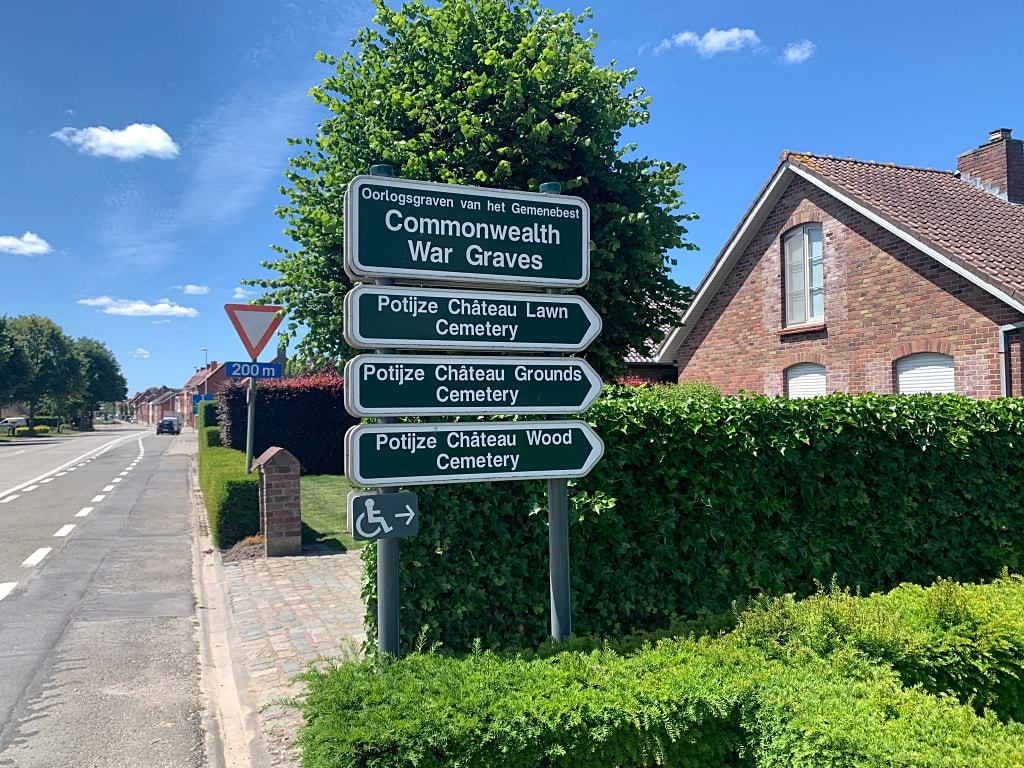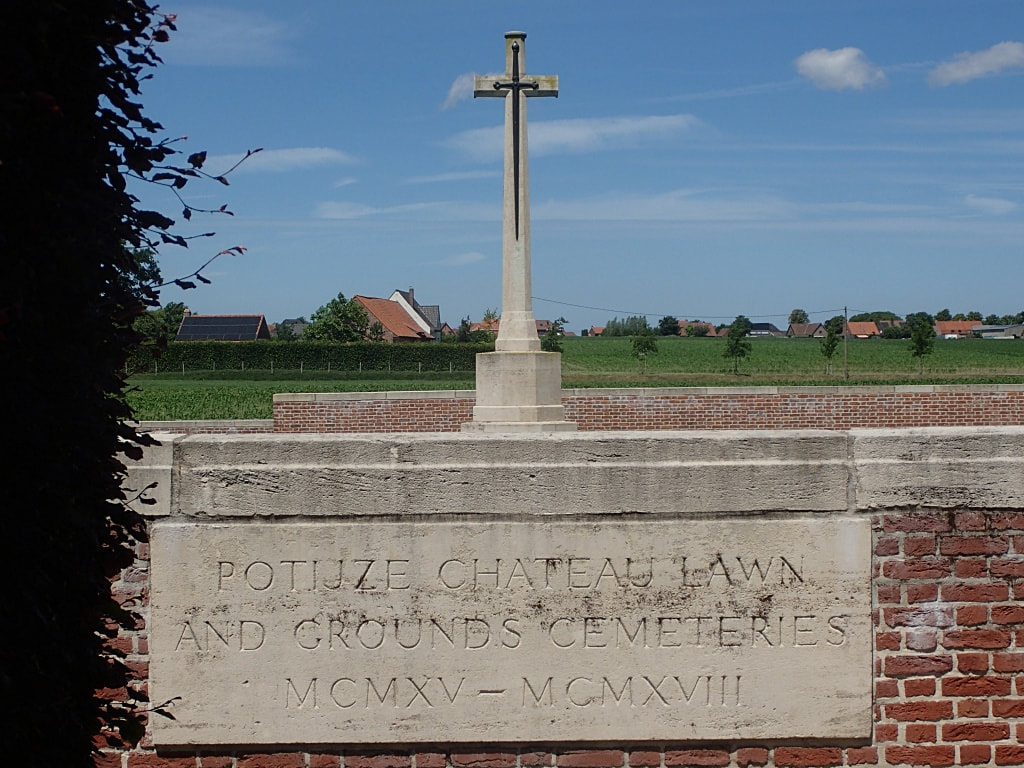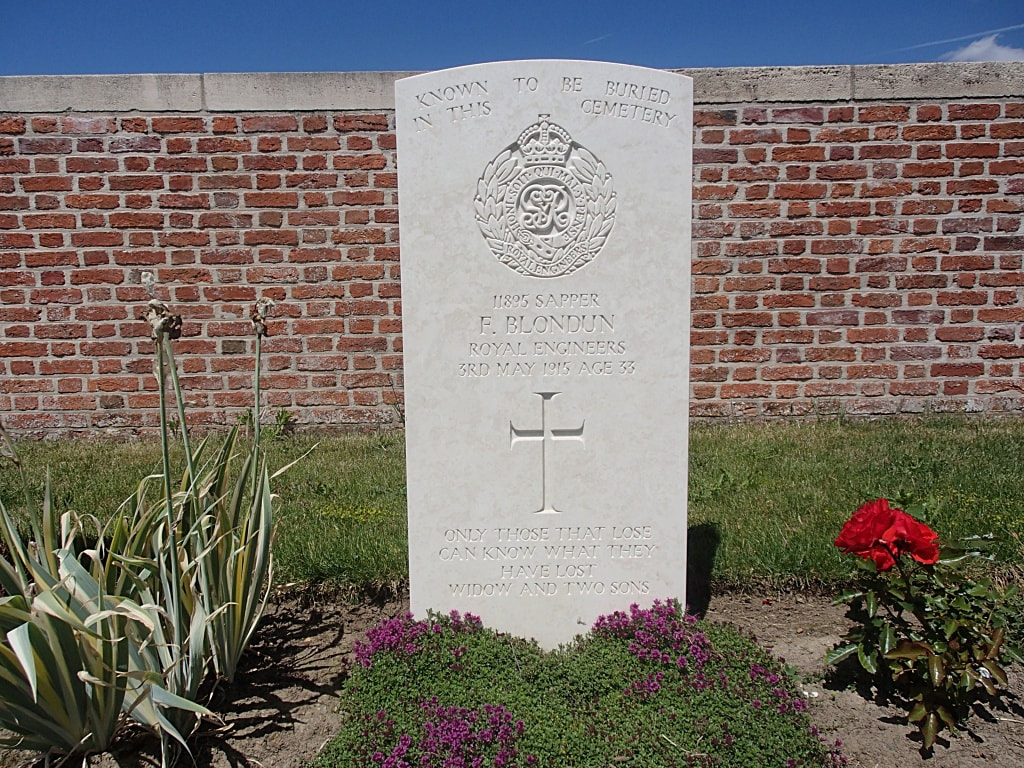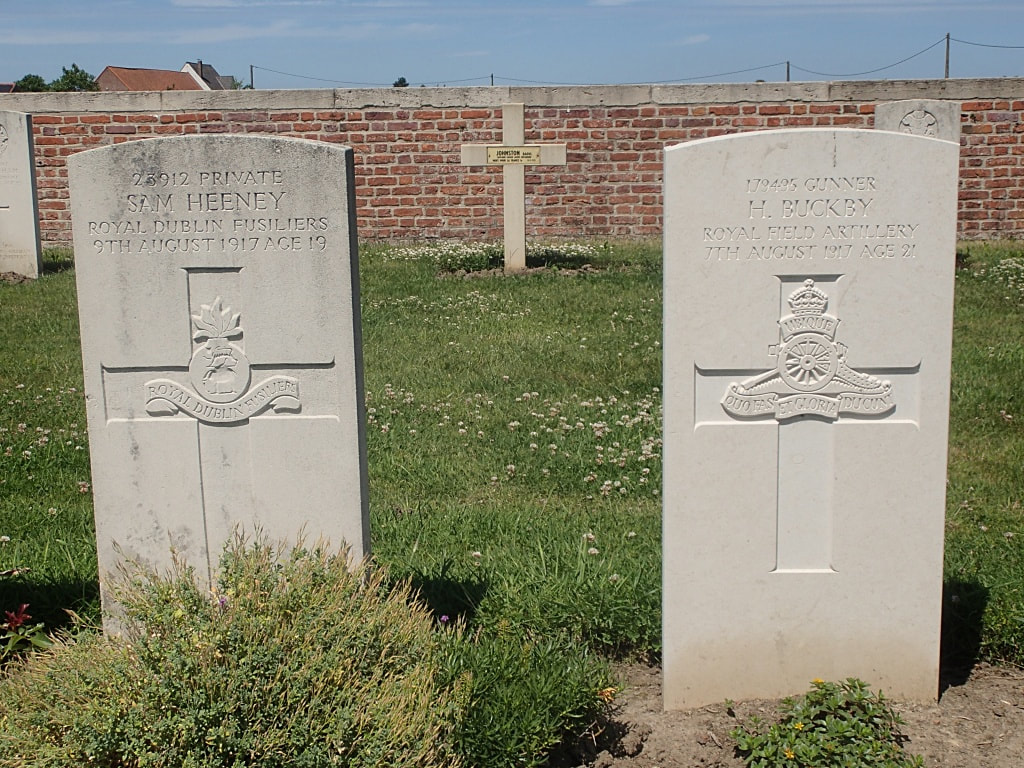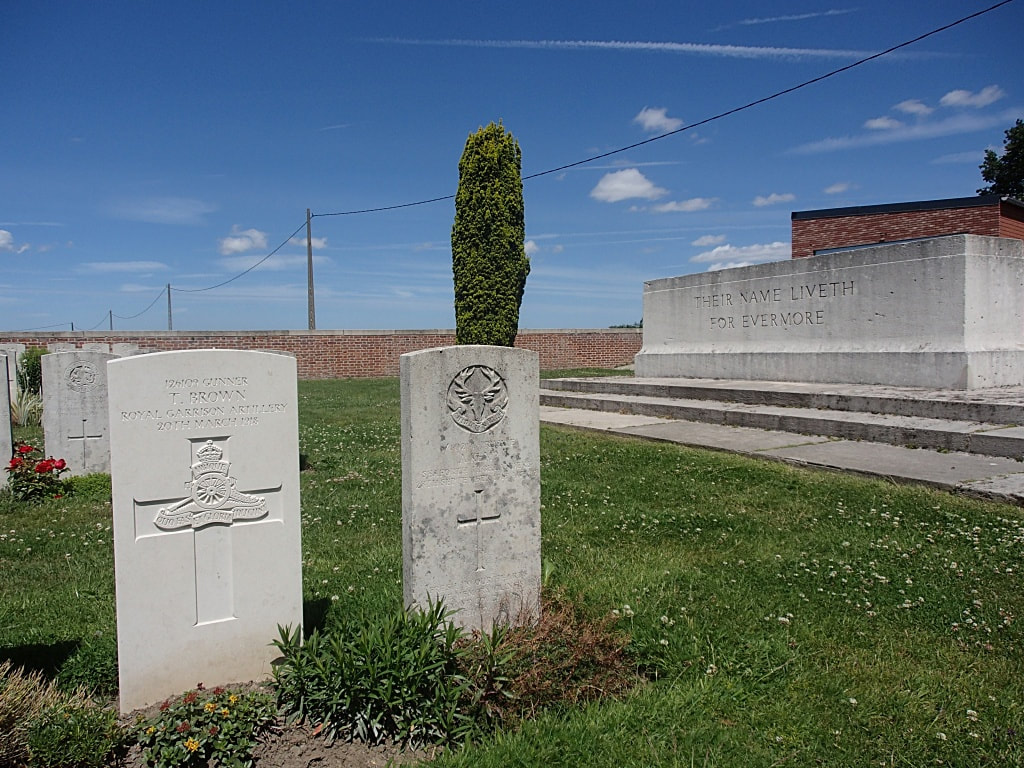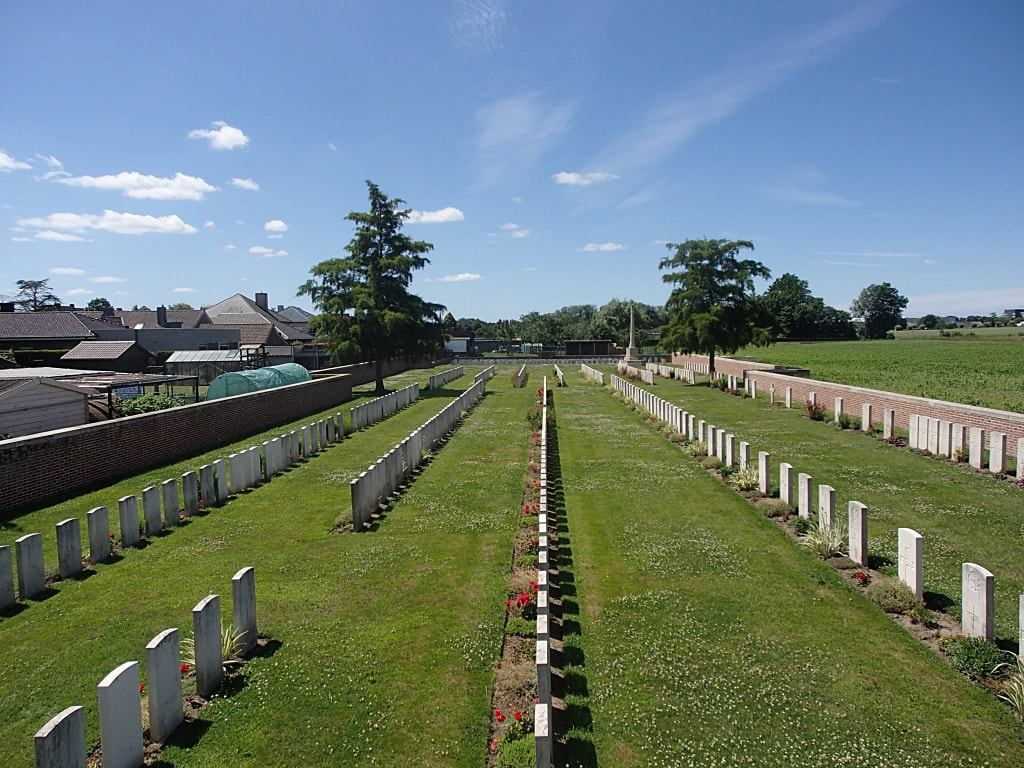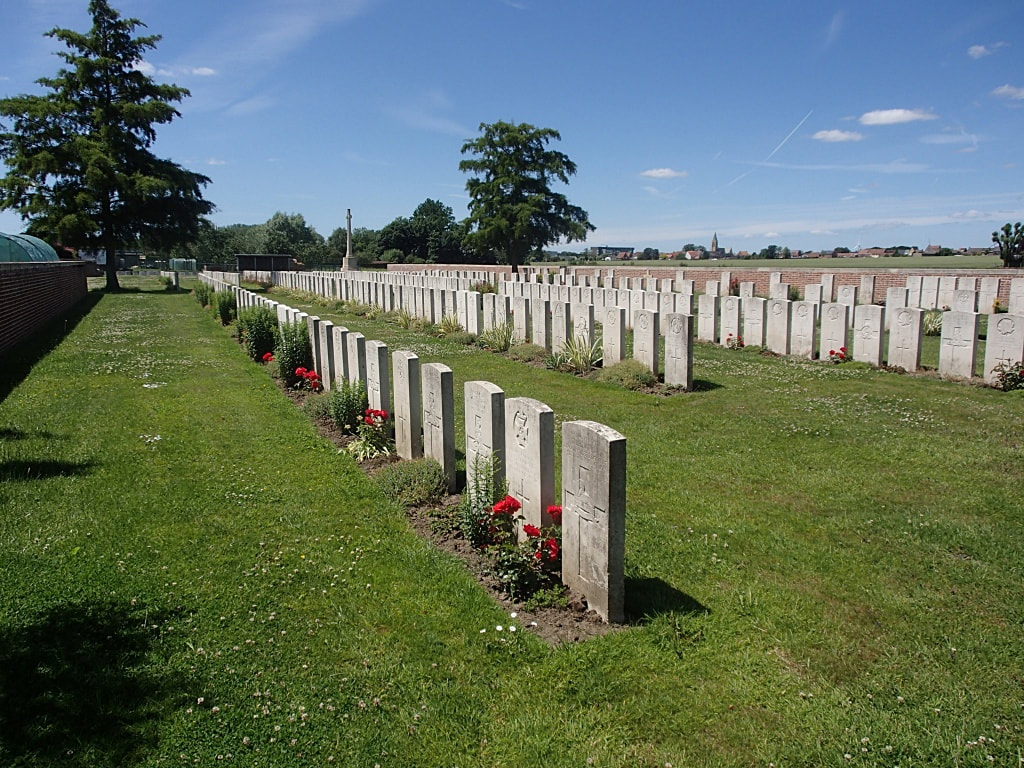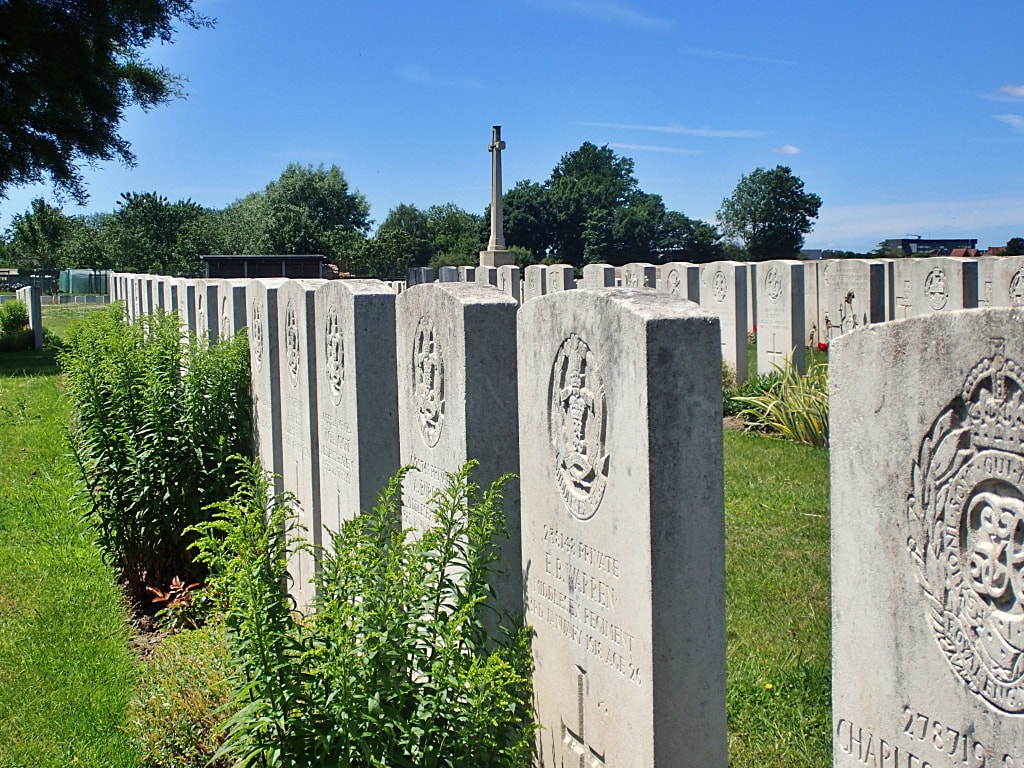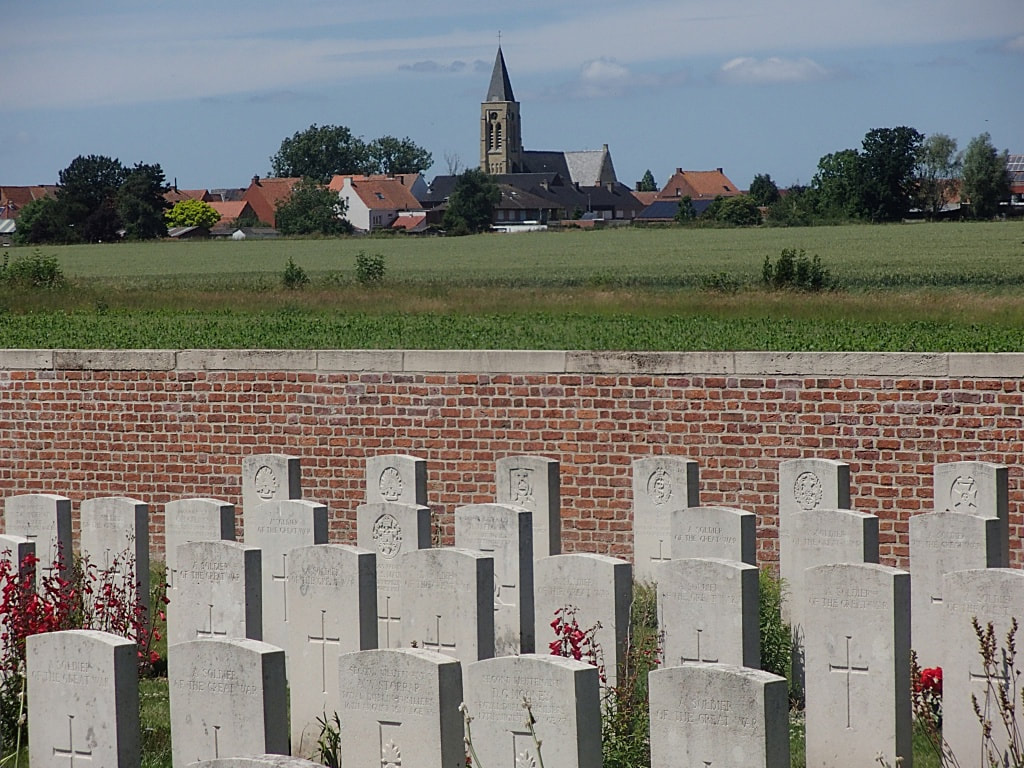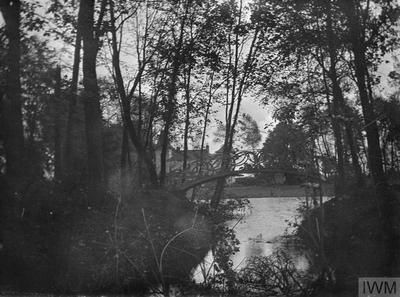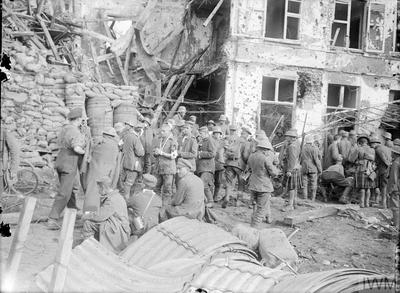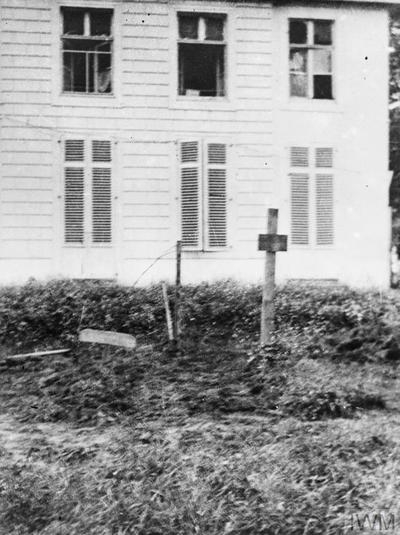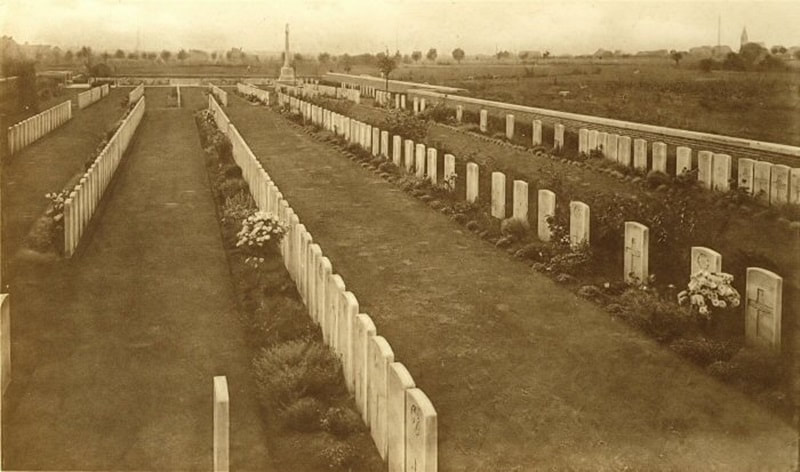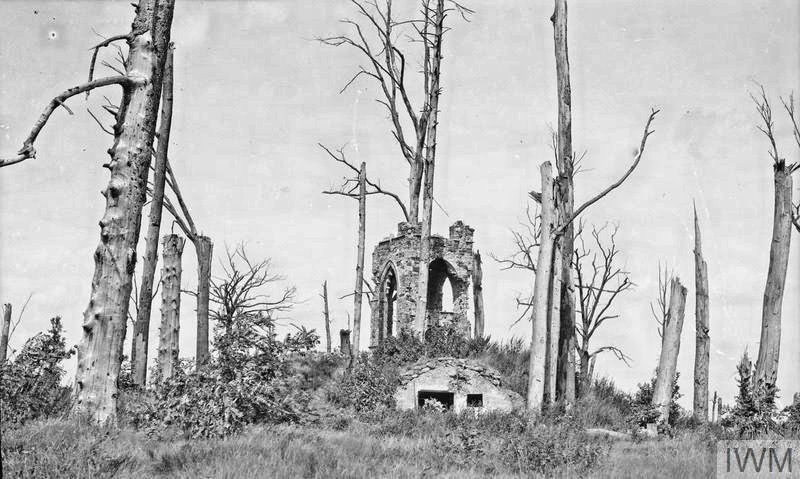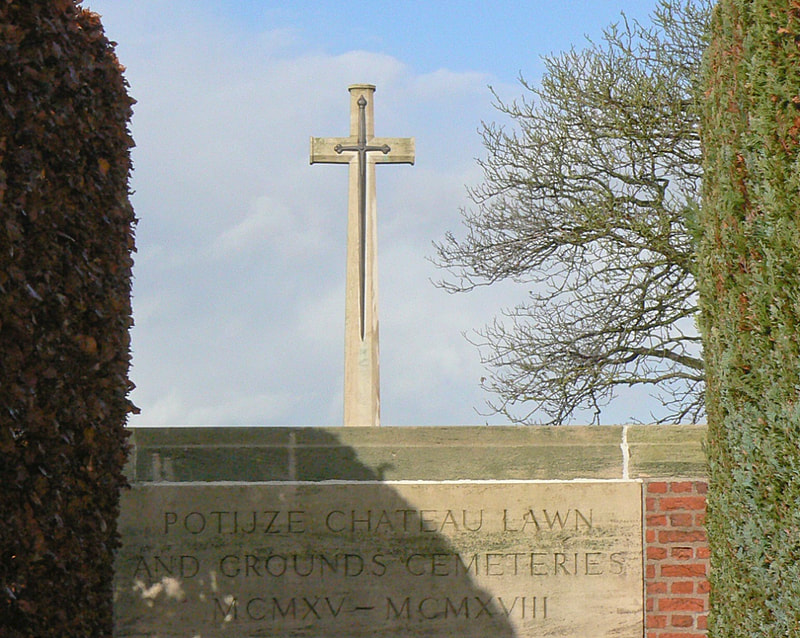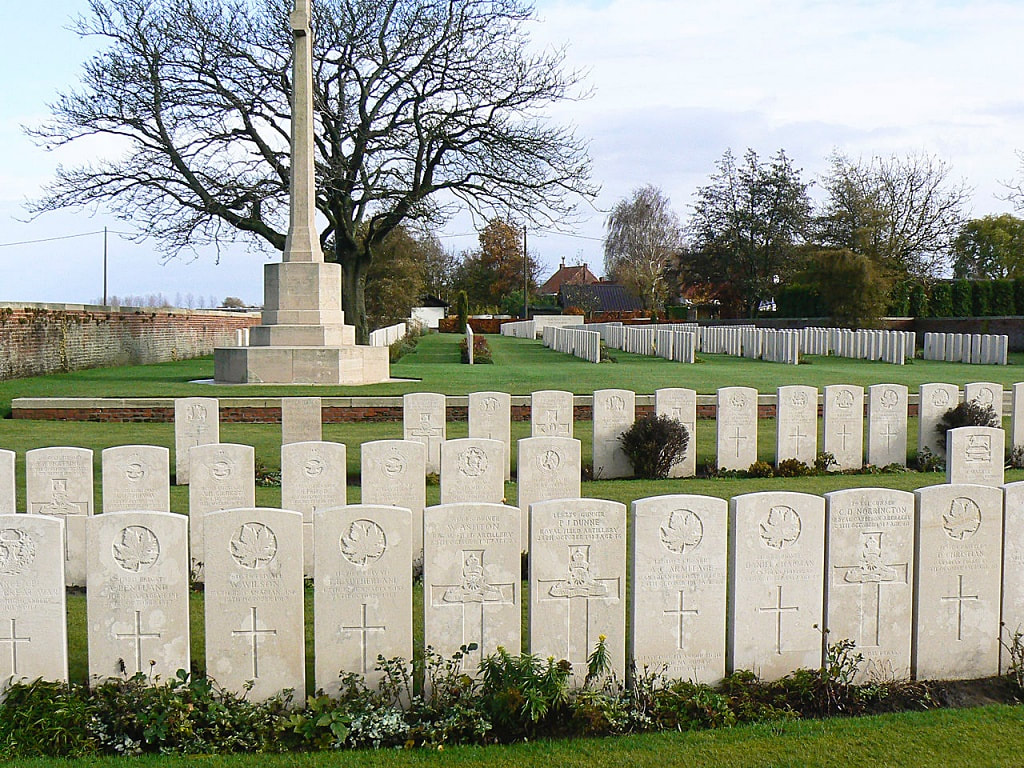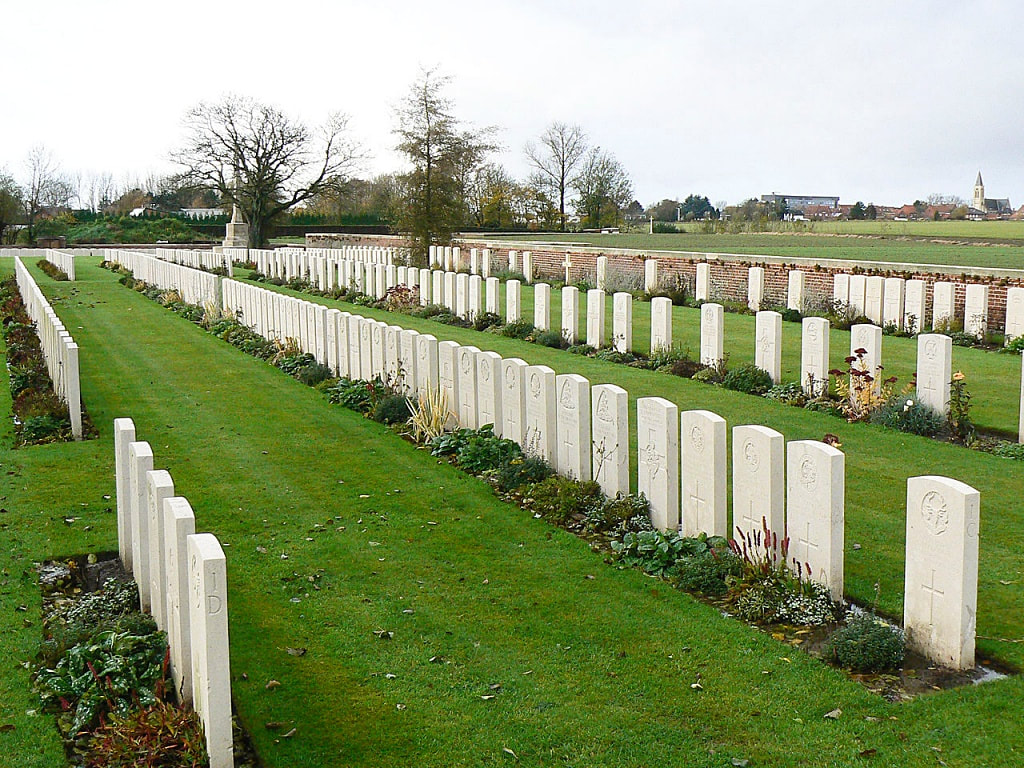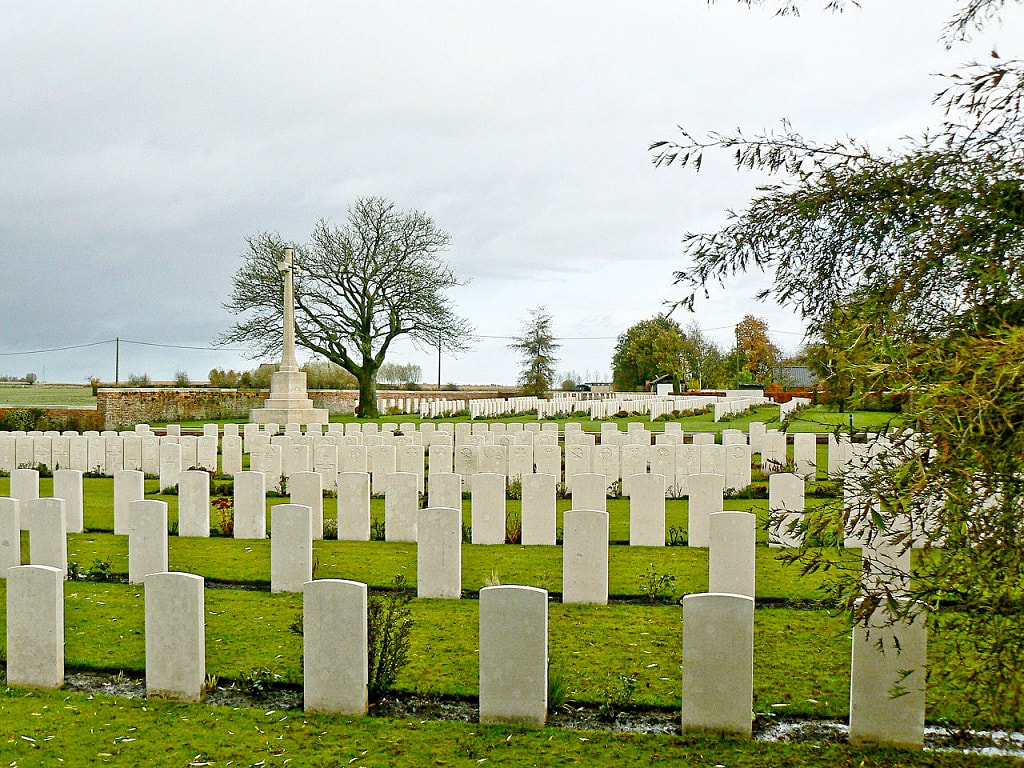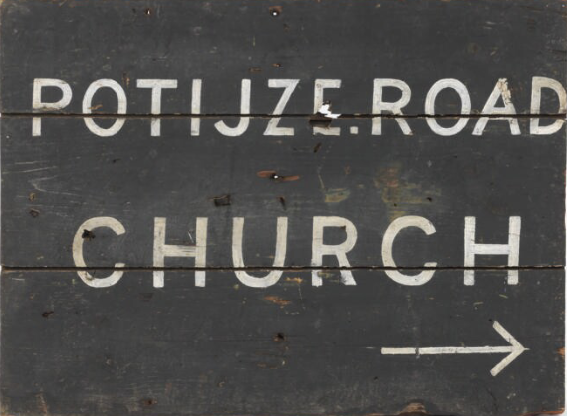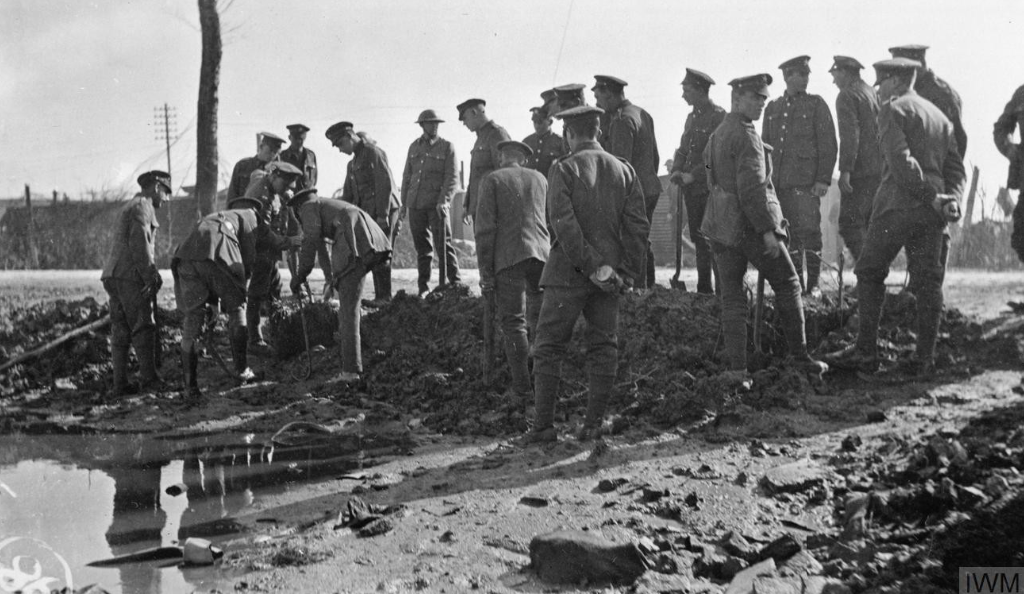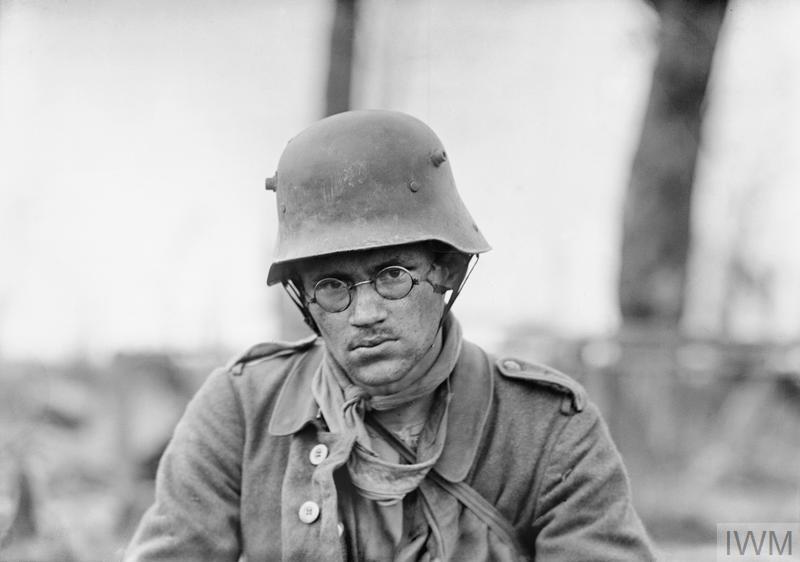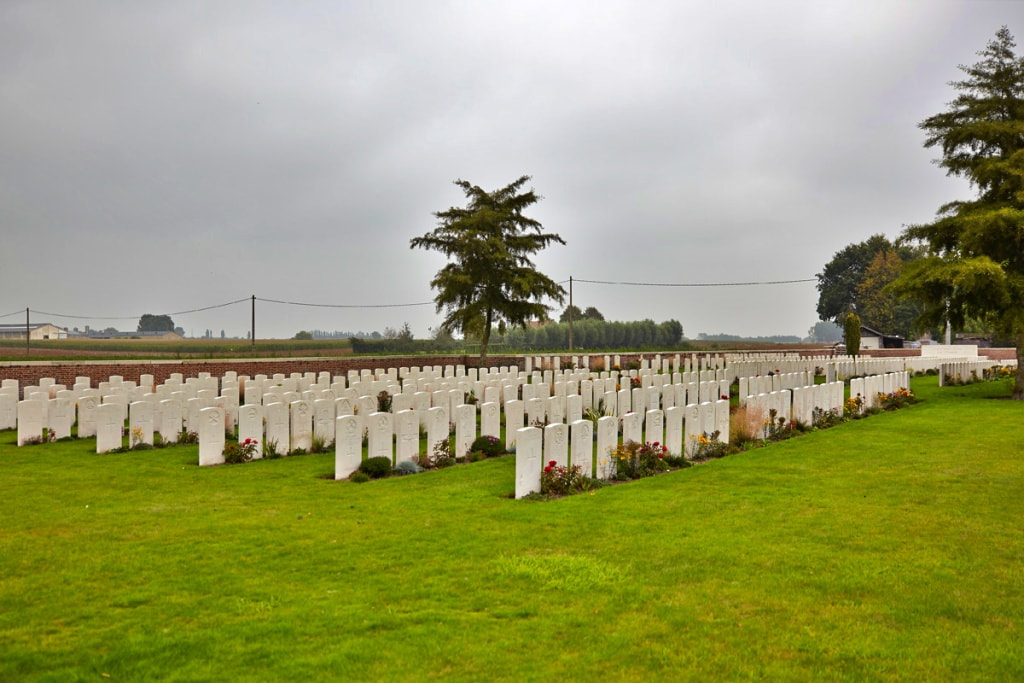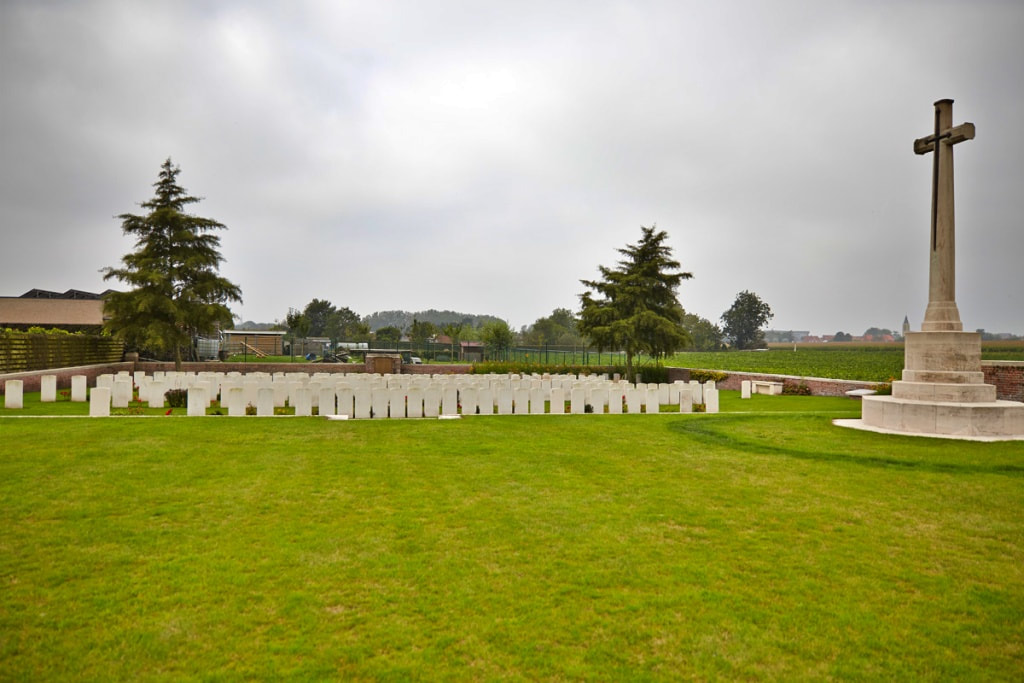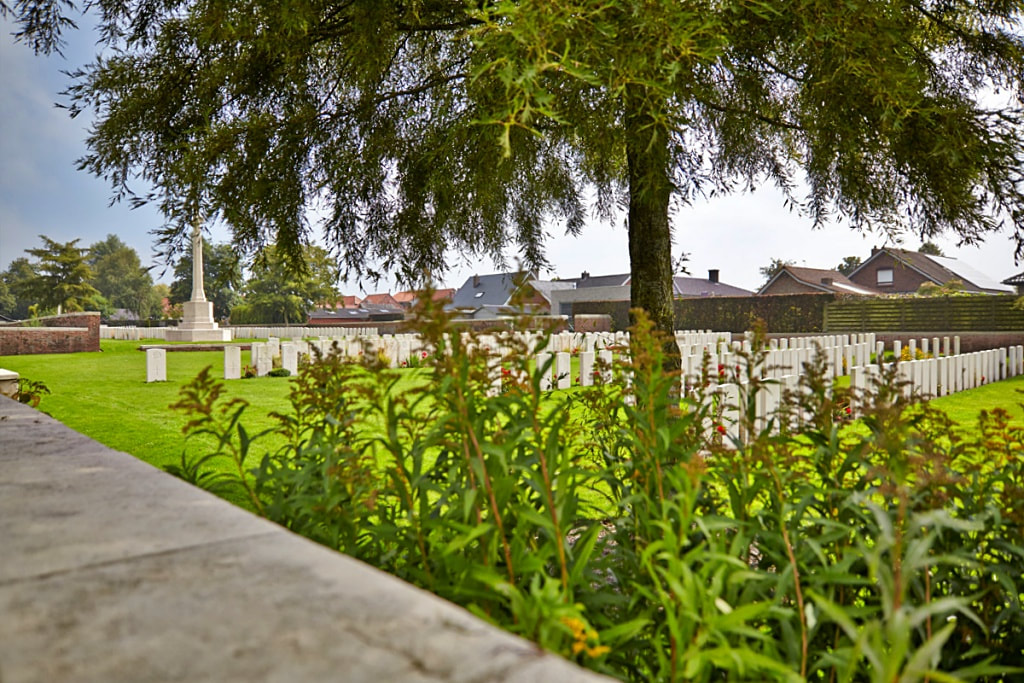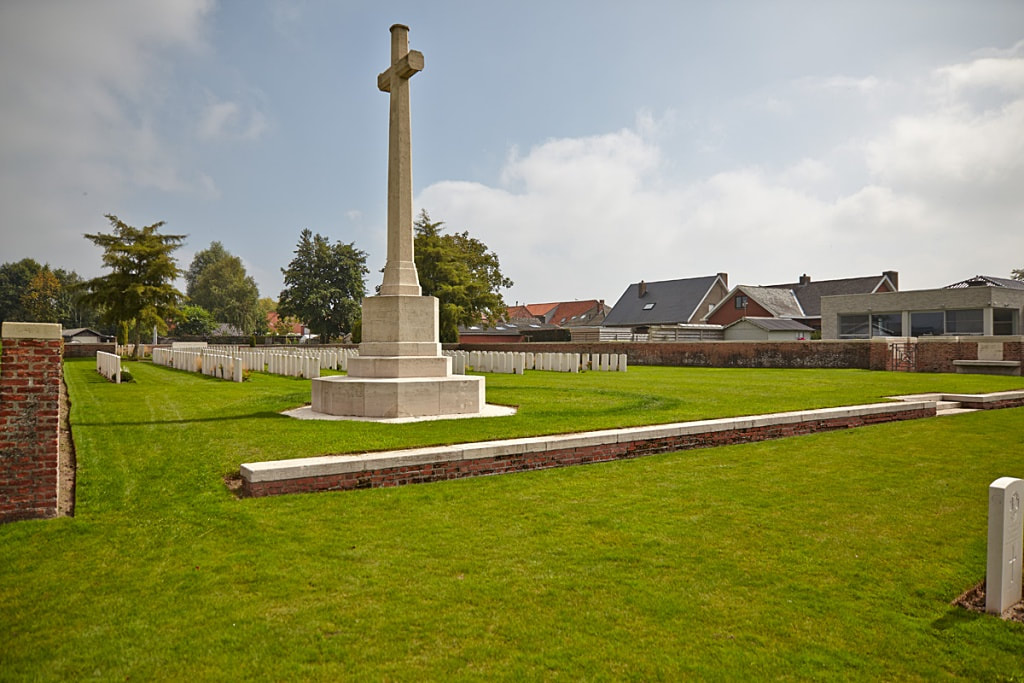POTIJZE CHÂTEAU GROUNDS CEMETERY
West-Vlaanderen
Belgium
GPS Coordinates - Latitude: 50.86119, Longitude: 2.91548
Location Information
The cemetery is located to the North-East of the town of Ieper. From the station turn left and drive along M.Fochlaan to the roundabout, turn right and go to the next roundabout. Here turn left into M.Haiglaan and drive to the next roundabout. Here turn right into Oude Veurnestraat, this then changes into Diksmuidseweg and Brugseweg. Drive along this road and continue straight over the traffic lights to the end of the road. At the T junction turn left (still Brugseweg) and continue along this road (the N313) to the village of Sint Jan. At the crossroads in the village turn right onto the N345 (Potijzestraat), follow along to the next crossroads and turn left into Zonnebeekseweg. The cemetery is located on the left hand side by the cross roads.
Visiting Information
Wheelchair access to this site is possible, but may be by an alternative entrance.
Historical Information
The Potijze Chateau Cemeteries
The old chateau grounds at Potijze are the site of three Commonwealth War Graves Commission cemeteries containing 864 Commonwealth burials of the First World War. Potijze Château Grounds, Potijze Château Lawn, and Potijze Château Wood cemeteries were all formed in the spring of 1915 and used for the burial of Commonwealth soldiers until 1918. The architectural features of the cemeteries were designed by Sir Reginald Blomfield and Noel Ackroyd Rew in the 1920's.
Potijze Château Grounds Cemetery
Château Grounds Cemetery was used from May 1915 to September 1918, and during that time 241 soldiers were buried in Plot I. Plot II was formed after the Armistice by the concentration of 225 bodies from isolated graves and small graveyards from the country North-East of Potijze.
Total Burials: 478.
Identified Casualties: United Kingdom 293, Canada 47, Australia 22, New Zealand 2, South Africa 1. Total 365.
Potijze Château Wood Cemetery
Château Wood Cemetery was used from April 1915 to June 1917, and three times in 1918. It contains 157 Commonwealth war graves. In Row A are buried 46 officers and men of the 2nd Hampshire Regiment, and in Rows E and F, 19 of the 1st Royal Inniskilling Fusiliers, who fell in a gas attack in August 1916.
Total Burials: 157.
Identified Casualties: United Kingdom 145, Canada 6. Total 151.
Potijze Château Lawn Cemetery
Château Lawn Cemetery was used from May to December 1915 and from July 1917 to October 1918. It contains 226 Commonwealth war graves and 3 German graves.
Total Burials: 229.
Identified Casualties: United Kingdom 162, Canada 22, South Africa 9, Australia 4, Germany 2. Total 199.
The cemetery is located to the North-East of the town of Ieper. From the station turn left and drive along M.Fochlaan to the roundabout, turn right and go to the next roundabout. Here turn left into M.Haiglaan and drive to the next roundabout. Here turn right into Oude Veurnestraat, this then changes into Diksmuidseweg and Brugseweg. Drive along this road and continue straight over the traffic lights to the end of the road. At the T junction turn left (still Brugseweg) and continue along this road (the N313) to the village of Sint Jan. At the crossroads in the village turn right onto the N345 (Potijzestraat), follow along to the next crossroads and turn left into Zonnebeekseweg. The cemetery is located on the left hand side by the cross roads.
Visiting Information
Wheelchair access to this site is possible, but may be by an alternative entrance.
Historical Information
The Potijze Chateau Cemeteries
The old chateau grounds at Potijze are the site of three Commonwealth War Graves Commission cemeteries containing 864 Commonwealth burials of the First World War. Potijze Château Grounds, Potijze Château Lawn, and Potijze Château Wood cemeteries were all formed in the spring of 1915 and used for the burial of Commonwealth soldiers until 1918. The architectural features of the cemeteries were designed by Sir Reginald Blomfield and Noel Ackroyd Rew in the 1920's.
Potijze Château Grounds Cemetery
Château Grounds Cemetery was used from May 1915 to September 1918, and during that time 241 soldiers were buried in Plot I. Plot II was formed after the Armistice by the concentration of 225 bodies from isolated graves and small graveyards from the country North-East of Potijze.
Total Burials: 478.
Identified Casualties: United Kingdom 293, Canada 47, Australia 22, New Zealand 2, South Africa 1. Total 365.
Potijze Château Wood Cemetery
Château Wood Cemetery was used from April 1915 to June 1917, and three times in 1918. It contains 157 Commonwealth war graves. In Row A are buried 46 officers and men of the 2nd Hampshire Regiment, and in Rows E and F, 19 of the 1st Royal Inniskilling Fusiliers, who fell in a gas attack in August 1916.
Total Burials: 157.
Identified Casualties: United Kingdom 145, Canada 6. Total 151.
Potijze Château Lawn Cemetery
Château Lawn Cemetery was used from May to December 1915 and from July 1917 to October 1918. It contains 226 Commonwealth war graves and 3 German graves.
Total Burials: 229.
Identified Casualties: United Kingdom 162, Canada 22, South Africa 9, Australia 4, Germany 2. Total 199.
Potijze during the First World War
For almost the entire period of the First World War the village of Potijze was held by the Commonwealth forces but stood directly behind the Allied trenches and was well within range of German guns. It was here that soldiers entered the communication and support trenches that led to the front-line. Although subject to constant shell fire Potijze Chateau, a country house dating from the nineteenth century, remained intact throughout the war and was occupied and used by Commonwealth troops. In the spring of 1915, during the Second Battle of Ypres, it was headquarters of the 27th Division, then under the command of Major-General Thomas D’Oyly Snow. The ground floor was later used as an Advanced Dressing Station while the first floor, which commanded views of the German lines, served as an observation post. For much of the war the Chateau was surrounded by a cluster of dug-outs and trenches and a large shed on the grounds, known to soldiers as ‘Lancer Farm’, housed ammunition and trench stores. Working parties would pause here to collect tools, coils of barbed wire, duckboards, bombs and other supplies before moving up the line.
There was particularly heavy fighting in the vicinity of Potijze in August 1917 during the opening phase of the Third Battle of Ypres, also known as ‘Passchendaele’. A young officer serving with the Manchester Regiment later recalled the devastation caused to the landscape around the Chateau by the relentless British and German artillery fire:
'This was a country where the desire to kill and destroy had developed to an unimaginable intensity. Nothing of use was to be left by either side, and every yard of ground almost was searched by the gunners to carry out their cruel game.'
Yet Potijze was never a quiet sector. On 9 August 1916, as the Somme offensive raged further south, the first and second battalions of the Hampshire Regiment spent ten days in trenches just east of the Chateau. As they were preparing to leave the Germans staged a surprise attack using a potent form of phosgene gas. Both units were caught unawares and although no ground was conceded the regiment suffered over 240 casualties, about half of whom were killed. The 1st Royal Inniskilling Fusiliers were stationed on the same stretch of front and also suffered numerous gas casualties. Over 60 men who fell in the attack are buried in rows A, E, and F of Chateau Wood Cemetery.
Edmund Blunden, a young English officer serving with the Royal Sussex Regiment, was stationed here at the beginning of 1917. He later recalled the atmosphere of Potijze during the third winter of the war:
'The new year was yet very young when the battalion filed through Ypres to take over the trenches at Potijze, which we came to know very well. It was not the worst place in the Salient. I had seen it already, and its arrangement was simple – a breastwork front line, running from Zonnebeke road to a railway bank on the south; a support line; two good (or not too bad) communication trenches – Haymarket and Piccadilly, Battalion headquarters dugout was near Potijze Château, beside the road. It boasted a handsome cheval-glass and a harmonium, but not a satisfactory roof. This headquarters also enjoyed a kind of Arcadian environment, for the late owner had constructed two or three ponds in the grounds with white airy bridges spanning them, weeping willows at their marges, and there were even statues of Venus and other handsome deities on little eminences, although I did not examine them closely. The château itself, much injured as it was, was not destroyed, and in the upper storey my observers gazed through a telescope on a dubious landscape; lucky these, whose day could not begin before eight, and ended at four with the thickening of what little light there had been. Littered on the damp floor beside them were maps of parts of the estate, some of a great age, and log-books of the number of woodcock, hares, rabbits and I forget what, formerly laid low by shooting parties of this fine house.'
In the decades after the war, Blunden became a celebrated poet and author, and his memoir, Undertones of War, is considered a classic of First World War literature. In the 1960s he acted as a commissioner with the Commonwealth War Graves Commission.
For almost the entire period of the First World War the village of Potijze was held by the Commonwealth forces but stood directly behind the Allied trenches and was well within range of German guns. It was here that soldiers entered the communication and support trenches that led to the front-line. Although subject to constant shell fire Potijze Chateau, a country house dating from the nineteenth century, remained intact throughout the war and was occupied and used by Commonwealth troops. In the spring of 1915, during the Second Battle of Ypres, it was headquarters of the 27th Division, then under the command of Major-General Thomas D’Oyly Snow. The ground floor was later used as an Advanced Dressing Station while the first floor, which commanded views of the German lines, served as an observation post. For much of the war the Chateau was surrounded by a cluster of dug-outs and trenches and a large shed on the grounds, known to soldiers as ‘Lancer Farm’, housed ammunition and trench stores. Working parties would pause here to collect tools, coils of barbed wire, duckboards, bombs and other supplies before moving up the line.
There was particularly heavy fighting in the vicinity of Potijze in August 1917 during the opening phase of the Third Battle of Ypres, also known as ‘Passchendaele’. A young officer serving with the Manchester Regiment later recalled the devastation caused to the landscape around the Chateau by the relentless British and German artillery fire:
'This was a country where the desire to kill and destroy had developed to an unimaginable intensity. Nothing of use was to be left by either side, and every yard of ground almost was searched by the gunners to carry out their cruel game.'
Yet Potijze was never a quiet sector. On 9 August 1916, as the Somme offensive raged further south, the first and second battalions of the Hampshire Regiment spent ten days in trenches just east of the Chateau. As they were preparing to leave the Germans staged a surprise attack using a potent form of phosgene gas. Both units were caught unawares and although no ground was conceded the regiment suffered over 240 casualties, about half of whom were killed. The 1st Royal Inniskilling Fusiliers were stationed on the same stretch of front and also suffered numerous gas casualties. Over 60 men who fell in the attack are buried in rows A, E, and F of Chateau Wood Cemetery.
Edmund Blunden, a young English officer serving with the Royal Sussex Regiment, was stationed here at the beginning of 1917. He later recalled the atmosphere of Potijze during the third winter of the war:
'The new year was yet very young when the battalion filed through Ypres to take over the trenches at Potijze, which we came to know very well. It was not the worst place in the Salient. I had seen it already, and its arrangement was simple – a breastwork front line, running from Zonnebeke road to a railway bank on the south; a support line; two good (or not too bad) communication trenches – Haymarket and Piccadilly, Battalion headquarters dugout was near Potijze Château, beside the road. It boasted a handsome cheval-glass and a harmonium, but not a satisfactory roof. This headquarters also enjoyed a kind of Arcadian environment, for the late owner had constructed two or three ponds in the grounds with white airy bridges spanning them, weeping willows at their marges, and there were even statues of Venus and other handsome deities on little eminences, although I did not examine them closely. The château itself, much injured as it was, was not destroyed, and in the upper storey my observers gazed through a telescope on a dubious landscape; lucky these, whose day could not begin before eight, and ended at four with the thickening of what little light there had been. Littered on the damp floor beside them were maps of parts of the estate, some of a great age, and log-books of the number of woodcock, hares, rabbits and I forget what, formerly laid low by shooting parties of this fine house.'
In the decades after the war, Blunden became a celebrated poet and author, and his memoir, Undertones of War, is considered a classic of First World War literature. In the 1960s he acted as a commissioner with the Commonwealth War Graves Commission.
Potijze Chateau
Potijze Chateau Grounds Cemetery nearest the camera, the Lawn cemetery is the other side of the cross and the Woods cemetery is outside the boundary wall to the right.
Images in this gallery © Werner Van Caneghem

240442 Private
Thomas Clark Bentham
"A" Coy. 2nd/5th Bn. East Lancashire Regiment
3rd December 1917, aged 24.
Plot I. D. 27.
Son of Joseph and Sarah Jane Bentham, of 8, Earl St., Colne, Lancs.
Thomas Clark Bentham
"A" Coy. 2nd/5th Bn. East Lancashire Regiment
3rd December 1917, aged 24.
Plot I. D. 27.
Son of Joseph and Sarah Jane Bentham, of 8, Earl St., Colne, Lancs.
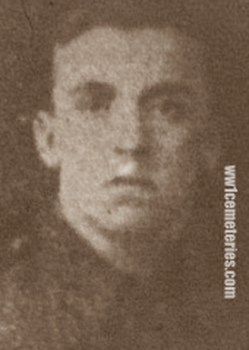
426173 Lance Corporal
John Eastham
419th Field Coy. Royal Engineers
31st July 1917, aged 30.
Plot II. B. 5.
Son of John and Amelia Eastham, of Croston, Preston; husband of A. Ratcliffe (formerly Eastham), of Mill Brook Cottages, Eccleston, St. Helens.
John Eastham
419th Field Coy. Royal Engineers
31st July 1917, aged 30.
Plot II. B. 5.
Son of John and Amelia Eastham, of Croston, Preston; husband of A. Ratcliffe (formerly Eastham), of Mill Brook Cottages, Eccleston, St. Helens.

Second Lieutenant
Cyril Douglas Herron
2nd Dragoon Guards (Queen's Bays)
13th May 1915
Plot I. A. 11.
Cyril Douglas Herron
2nd Dragoon Guards (Queen's Bays)
13th May 1915
Plot I. A. 11.
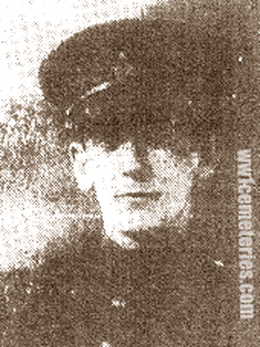
629576 Private
William E. James
47th Bn. Canadian Infantry
5th November 1917
Plot I. C. 28.
William E. James
47th Bn. Canadian Infantry
5th November 1917
Plot I. C. 28.
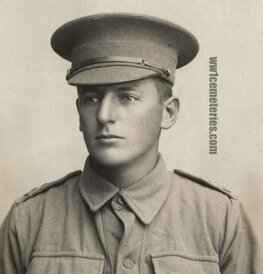
626 Corporal
Leslie Reed Langtry
4th Australian Light Horse
4th December 1917, aged 27.
Plot I. D. 29.
Son of Samuel and Louisa Langtry, of Moulamein, New South Wales. Native of Nhill, Victoria, Australia.
A farmer from Benalla, Victoria prior to enlistment, L Cpl Langtry embarked with the 1st Reinforcements from Melbourne on HMAT Barunga on 22 December 1914. After serving at Gallipoli he transferred to the 1st Anzac Mounted Regiment where he was promoted to Corporal. Later transferring to the 2nd Anzac Mounted Regiment, he was killed in action on 4 December 1917, aged 27, and was buried in the Potijze Chateau Grounds Cemetery Belgium. His younger brother 1868 Private Winston Merlin Langtry was killed in action in Belgium on 4 October 1917. He is now buried in the Tyne Cot Cemetery.
Leslie Reed Langtry
4th Australian Light Horse
4th December 1917, aged 27.
Plot I. D. 29.
Son of Samuel and Louisa Langtry, of Moulamein, New South Wales. Native of Nhill, Victoria, Australia.
A farmer from Benalla, Victoria prior to enlistment, L Cpl Langtry embarked with the 1st Reinforcements from Melbourne on HMAT Barunga on 22 December 1914. After serving at Gallipoli he transferred to the 1st Anzac Mounted Regiment where he was promoted to Corporal. Later transferring to the 2nd Anzac Mounted Regiment, he was killed in action on 4 December 1917, aged 27, and was buried in the Potijze Chateau Grounds Cemetery Belgium. His younger brother 1868 Private Winston Merlin Langtry was killed in action in Belgium on 4 October 1917. He is now buried in the Tyne Cot Cemetery.
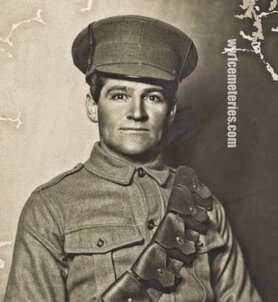
136 Driver
Alexander McKernan
3rd Field Ambulance, Australian Army Medical Corps
31st October 1917, aged 32.
Plot I. C. 6.
Son of John and Matilda McKernan.
From Euroa, Vic. A farmer prior to enlistment, he embarked from Melbourne, Victoria aboard RMS Mooltan on18 May 1915. Alexander McKernan transferred to the 3rd Field Ambulance with the rank of Driver in January 1916. He was killed in action on 31 October 1917, aged 32.
Alexander McKernan
3rd Field Ambulance, Australian Army Medical Corps
31st October 1917, aged 32.
Plot I. C. 6.
Son of John and Matilda McKernan.
From Euroa, Vic. A farmer prior to enlistment, he embarked from Melbourne, Victoria aboard RMS Mooltan on18 May 1915. Alexander McKernan transferred to the 3rd Field Ambulance with the rank of Driver in January 1916. He was killed in action on 31 October 1917, aged 32.

2167 Private
Frederick Gould Pullen
5th Australian Pioneers
4th November 1917, aged 26.
Special Memorial near Great Cross.
Son of Frederick Charles and Lucinda Caroline Pullen, of West Maitland, New South Wales.
A farmer from Maitland, NSW. Pte Pullen embarked from Sydney with the 3rd Reinforcements, 1st Pioneer Battalion on HMAT Clan MacGillivray (A46) on 3 May 1916. On arrival in Egypt he was transferred to the 5th Pioneer Battalion. He disembarked in France in June 1916, and throughout 1916 and early 1917 was hospitalised due to illness several times. He was killed in action on 4 November 1917 on the Passchendaele Ridge when he was hit in the head by a High Explosive shell.
Frederick Gould Pullen
5th Australian Pioneers
4th November 1917, aged 26.
Special Memorial near Great Cross.
Son of Frederick Charles and Lucinda Caroline Pullen, of West Maitland, New South Wales.
A farmer from Maitland, NSW. Pte Pullen embarked from Sydney with the 3rd Reinforcements, 1st Pioneer Battalion on HMAT Clan MacGillivray (A46) on 3 May 1916. On arrival in Egypt he was transferred to the 5th Pioneer Battalion. He disembarked in France in June 1916, and throughout 1916 and early 1917 was hospitalised due to illness several times. He was killed in action on 4 November 1917 on the Passchendaele Ridge when he was hit in the head by a High Explosive shell.


